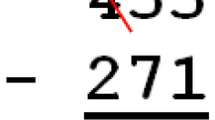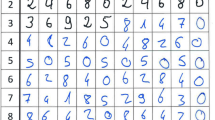Abstract
In this paper, dialogue among a group of adult women with basic adult education is examined. Women read books of mathematics in the context of a dialogic mathematics gathering (DMG). There is limited evidence in research on how adults develop their ‘numerical understanding’. The objective of this study is to analyze how adults engage in critical thinking on numeracy, expanding their skills when becoming critics as readers. Women participating in the DMG create a context in which they exchange reports of their personal experiences in making meaning for the mathematical objects appearing in the readings. Three different episodes are discussed, involving units of measurement, number system, and the concept of base. Using a methodological framework grounded on Freire’s work, evidence shows how those women unpack the mathematical meaning embedded in the readings, examining critically the objects discussed. DMGs result in a successful educational action to empower those women with low mathematics education experience.



Similar content being viewed by others
References
Addams, J. (1990). Twenty years at hull-house. Urbana and Chicago: University of Illinois Press.
Albers, P., Holbrook, T., & Flint, A. (2013). New methods of literacy research. New York: Routledge.
Baker, D. (2008). Using sand to count their number: Developing teachers’ cultural and social sensitivities. In J. Kalman & B. Street (Eds.), Preguntas sin respuestas. Lectura, escritura y matemáticas como prácticas sociales. Mexico DF: Siglo XXI.
Beck, U. (1992). Risk society: Towards a new modernity. Thousand Oaks: Sage.
Bourdieu, P. (2013). Distinction: A social critique of the judgment of taste. New York: Routledge.
Boyer, C. B. (1986). Historia de la matemática. Madrid: Alianza Editorial.
Christou, M., & Puigvert, L. (2011). The role of ‘Other Women’s current educational transformations. International Studies in Sociology of Education,21(1), 77–90.
Coben, D. (2006). What is specific about research in adult numeracy and mathematics education? Adults Learning Mathematics,2(1), 18–32.
Coben, D., Colwell, D., Macrae, S., Boaler, J., Brown, M., & Rhodes, V. (2003). Adult numeracy: Review of research and related literature. London: National Research and Development Centre for adult literacy and numeracy.
Collette, J. P. (1985). Historia de las matemáticas. Madrid: Siglo XXI.
Condelli, L. (2006). A review of the literature in adult numeracy: Research and conceptual issues. Washington, DC: American Institue for Research.
Díez-Palomar, J. (2017). Mathematics Dialogic Gatherings: A way to create new possibilities to learn mathematics. Adults Learning Mathematics,12(1), 39–48.
Díez-Palomar, J. (2018). Editorial. Adults Learning Mathematics: An International Journal,13(1), 4–6.
Díez-Palomar, J., Hoogland, K., & Geiger, V. (2019). Numeracy in adult education: Discussing related concepts to enrich the numeracy assessment framework. CERME. Utrecht: ERME.
Díez-Palomar, J., Menéndez, J. M., & Civil, M. (2011). Learning mathematics with adult learners: Drawing from parents’ perspective. Revista Latinoamericana de Investigación En Matemática Educativa,14(1), 71–94.
Díez-Palomar, J., & Molina, S. (2009). Family mathematics education: Building dialogic spaces for adult learning mathematics. In D. Kaye (Ed.), Proceedings of the Adults Learning Mathematics Annual Meeting. London (UK): LLU.
FitzSimons, G. E. (2005). Can adult numeracy be taught? A Bernsteinian analysis. In M. Goos, C. Kanes, & R. Brown (Eds.), Mathematics education and society. Proceedings of the 4th international mathematics and society conference (pp. 155–165). Griffith University.
FitzSimons, G. E., & Godden, G. L. (2000). Review of research on adults learning mathematics. In D. Coben, J. O’Donoghue, & G. FitzSimons (Eds.), Perspectives on adults learning mathematics. Research and practice (pp. 13–45). New York: Springer.
Flecha, R. (2000). Sharing words: Theory and practice of dialogic learning. Oxford: Rowman & Littlefield.
Flecha, R. (2014). Successful educational actions for inclusion and social cohesion in Europe. Cham: Springer.
Freire, P. (1970a). Pedagogy of the oppressed. New York: Continuum.
Freire, P. (1970b). The adult literacy process as cultural action for freedom. Harvard Educational Review,40(2), 205–225.
Gal, I. (1993). Issues and challenges in adult numeracy. Philadelphia, PA: National Center on Adult Literacy.
Gal, I. (2000). Adult numeracy development: Theory, research, practice. Series on Literacy: Research, Policy, and Practice. Cresskill, NJ: Hampton Press.
Gal, I., Alatorre, S., Close, S., Evans, J., Johansen, L., Maguire, T., Manly, M., & Tout, D. (2009). PIAAC numeracy: A conceptual framework. OECD Education Working Papers, 35. Paris: OECD Publishing.
García-Carrión, R. (2015). What the dialogic literary gatherings did for me: The personal narrative of an 11-year-old boy in a rural community in England. Qualitative Inquiry,21(10), 913–919.
Garcia-Retamero, R., & Cokely, E. (2014). Using visual aids to help people with low numeracy make better decisions. In B. Anderson & J. Schulkin (Eds.), Numerical reasoning in judgments and decision making about health (pp. 153–174). Cambridge: Cambridge University Press.
Gee, J. P. (2004). An introduction to discourse analysis: Theory and method. New York: Routledge.
Geiger, V., Forgasz, H., & Goos, M. (2015a). A critical orientation to numeracy across the curriculum. ZDM Mathematics Education,47(4), 611–624.
Geiger, V., Goos, M., & Forgasz, H. (2015b). A rich interpretation of numeracy for the 21st century: A survey of the state of the field. ZDM Mathematics Education,47(4), 531–548.
Gómez, A., Puigvert, L., & Flecha, R. (2011). Critical communicative methodology: Informing real social transformation through research. Qualitative Inquiry,17(3), 235–245.
Gómez, A., Racionero, S., & Sordé, T. (2010). Ten years of critical communicative methodology. International Review of Qualitative Research,3(1), 17–43.
Gutstein, E. (2006). Reading and writing the world with mathematics: Toward a pedagogy for social justice. New York: Taylor & Francis.
Habermas, J. (2002). On the pragmatics of social interaction: Preliminary studies in the theory of communicative action. Cambridge, MA: MIT Press.
Hoogland, K., Auer, M., Díez-Palomar, J., O’Meara, N., & Van Groenestijn, M. (2019). Initiating a common european numeracy framework. CERME. Utrecht: ERME.
Hoogland, K., Díez-Palomar, J., & Vliegenthart, M. (2018). Towards a European numeracy framework. Adults learning mathematics: Adults learning mathematics in a fractured world. London. Boundaries and bridges: ALM.
Hoogland, K., & Tout, D. (2018). Computer-based assessment of mathematics into the twenty-first century: pressures and tensions. ZDM Mathematics Education,50(4), 675–686.
Ifrah, G. (1987). Las cifras: Historia de una gran invención. Madrid: Alianza Editorial.
Jarvis, P. (2004). Adult education and lifelong learning: Theory and practice. New York: Routledge.
Kaye, D. (2018). Defining adult and numeracy: An academic and political investigation. In K. Safford-Ramus, J. Maaß, & E. Süss-Stepancik (Eds.), Contemporary research in adult and lifelong learning of mathematics. ICME-13 Monographs (pp. 11–37). Cham: Springer.
Kline, M. (1999). El pensamiento matemático de la antigüedad a nuestros días. Madrid: Alianza Editorial.
Knijnik, G. (1996). Exclusão resistência: Educação matemática e legitimidade cultural. Porto Alegre, Brazil: Artes Médicas.
Lyles, C. R., & Sarkar, U. (2015). Health literacy, vulnerable patients, and health information technology use: Where do we go from here?. New York: Springer.
McIntosh, A., Reys, B. J., & Reys, R. E. (1992). A proposed framework for examining basic number sense. For the Learning of Mathematics,12(3), 2–8.
Mercer, N., Warwick, P., Kershner, R., & Staarman, J. K. (2010). Can the interactive whiteboard help to provide ‘dialogic space ‘for children’s collaborative activity? Language and Education,24(5), 367–384.
Mezirow, J. (2000). Learning as transformation: Critical perspectives on a theory in progress. San Francisco: Jossey-Bass.
Morton, T., McGuire, T., & Baynham, M. (2006). A literature review of research on teacher education in adult literacy, numerac, and ESOL. London: NRDC.
Panthi, R. K., Luitel, B. C., & Belbase, S. (2018). Teachers’ perception of social justice in mathematics classrooms. REDIMAT,7(1), 7–37.
Peters, E. (2012). Beyond comprehension: The role of numeracy in judgments and decisions. Current Directions in Psychological Science,21(1), 31–35.
Reyna, V. F., Nelson, W. L., Han, P. K., & Dieckmann, N. F. (2009). How numeracy influences risk comprehension and medical decision making. Psychological Bulletin,135(6), 943.
Safford-Ramus, K. (2017). Research in adult mathematics education: How far have we come, where might we go next? In C. Mac an Bhaird, J. Díez-Palomar, G. Griffiths, & A. O’Shea (Eds.), Numeracy: A critical skill in adult education. Maynooth: Maynooth University.
Safford-Ramus, K., Keogh, J., O'Donoghue, J., & Maguire, T. (Eds.). (2018). Adults learning mathematics - A research forum 1993–2018. Celebrating 25 years: A lot done, a lot more yet to do. London: ALM.
Safford-Ramus, K., Misra, P. K., & Maguire, T. (2016). The Troika of adult learners, lifelong learning, and mathematics. Learning from research, current paradoxes, tension, and promotional strategies. Berlin: Springer.
Sanchez, M. (1999). Voices inside schools—La Verneda-Sant Martí: A school where people dare to dream. Harvard Educational Review,69(3), 320–336.
Stake, R. E. (2013). Multiple case study analysis. New York: Guilford Press.
Tout, D., Coben, D., Geiger, V., Ginsburg, L., Hoogland, K., Maguire, T., et al. (2017). Review of the PIAAC numeracy assessment framework: Final report. Camberwell, Victoria: Australian Council for Educational Research and OECD.
Tout, D., & Gal, I. (2015). Perspectives on numeracy: Reflections from international assessments. ZDM Mathematics Education,47(4), 691–706.
Tygel, A. F., & Kirsch, R. (2016). Contributions of Paulo Freire for a critical data literacy: A popular education approach. The Journal of Community Informatics, 12(3), 108–121.
UNESCO. (1978). Records of the general conference, 20th Session, Paris, 24 October to 28 November 1978, v. 1. Resolutions. Paris: OECD Publishing.
Yasukawa, K., Rogers, A., Jackson, K., & Street, B. V. (2018). Numeracy as social practice: Global and local perspectives. New York: Routledge.
Yin, R. K. (1994). Case study research. Design and methods (2nd ed.). Thousand Oaks: Sage publications.
Funding
This study was funded by Ministerio de Ciencia, Innovación y Universidades (PEX19/00547).
Author information
Authors and Affiliations
Corresponding author
Additional information
Publisher's Note
Springer Nature remains neutral with regard to jurisdictional claims in published maps and institutional affiliations.
Rights and permissions
About this article
Cite this article
Díez-Palomar, J. Dialogic mathematics gatherings: encouraging the other women’s critical thinking on numeracy. ZDM Mathematics Education 52, 473–487 (2020). https://doi.org/10.1007/s11858-019-01092-2
Accepted:
Published:
Issue Date:
DOI: https://doi.org/10.1007/s11858-019-01092-2




